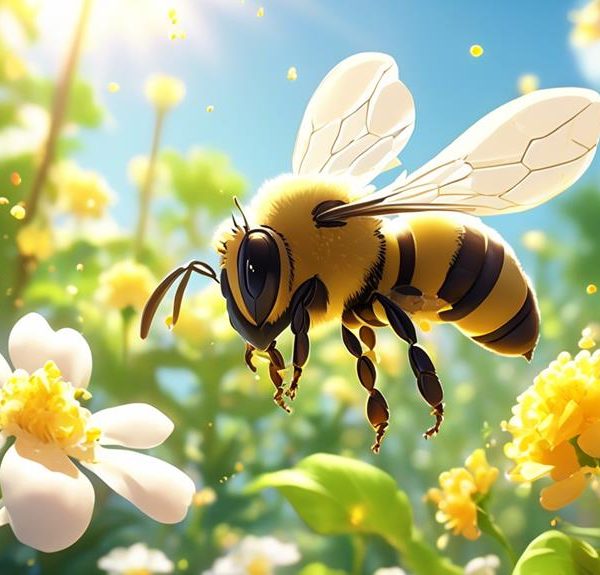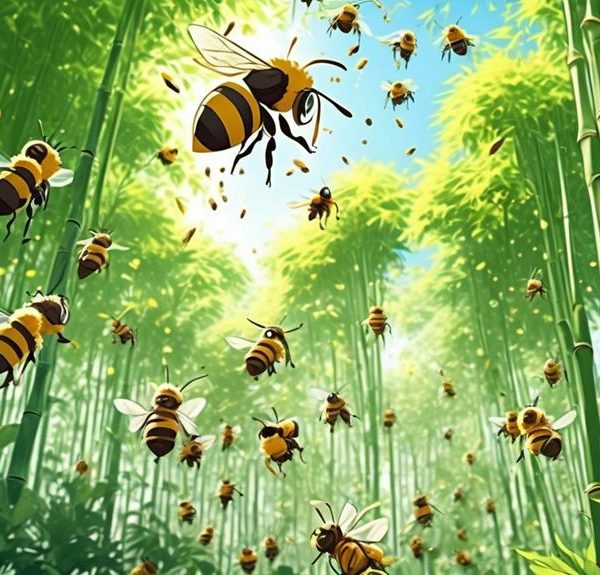Wondering if bees are attracted to balloon flowers? Discover the intricate relationship between these fascinating pollinators and these unique blooms in our deep dive.

Do Bees Like Balloon Flowers
You know what they say – 'you can catch more flies with honey than with vinegar.' But when it comes to bees, what's the secret to attracting these industrious pollinators?
You might be wondering whether balloon flowers, those charming, bell-shaped blooms that add a splash of color to any garden, could be the answer.
Well, the relationship between bees and balloon flowers is quite complex, and exploring it might just change the way you approach your gardening efforts.
Stay with me, as we're about to unravel this intriguing relationship – it promises to be quite a journey.
Key Takeaways
- Bees are attracted to bright colors such as yellow, blue, and violet, which are present in balloon flowers.
- Balloon flowers reflect ultraviolet light, making them visible and attractive to bees.
- Balloon flowers offer a generous amount of nectar with a high fructose content, which is particularly appealing to bees.
- The tubular and deep shape of balloon flowers is well-suited for bees' long tongues, allowing them easy access to the nectar and facilitating pollination.
Understanding Bees and Their Preferences
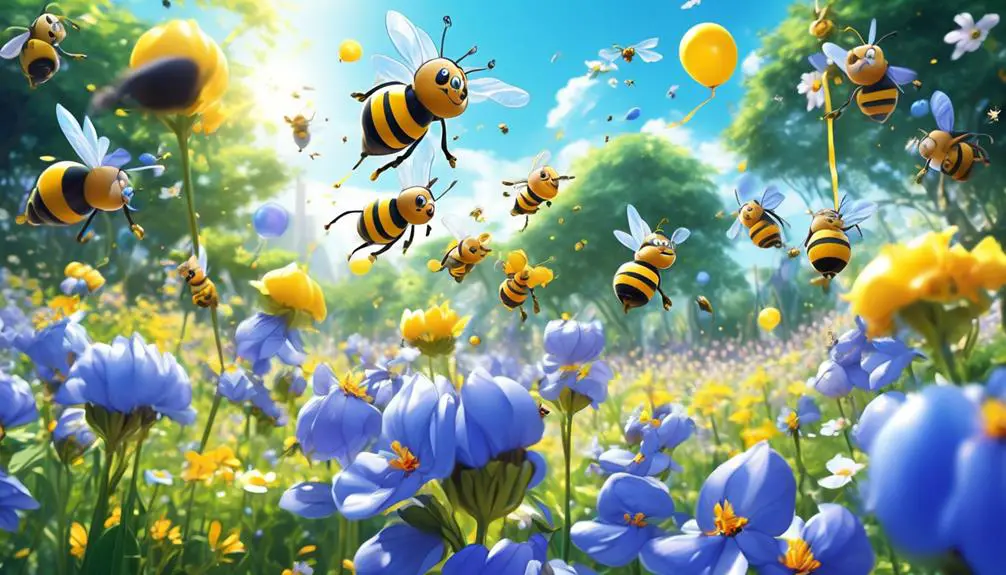
While it may seem like bees indiscriminately buzz from flower to flower, they actually have specific preferences based on the plant's color, scent, and nectar production. As a bee enthusiast or gardener, understanding these preferences can help you create a more bee-friendly environment.
Firstly, bees are attracted to bright colors such as yellow, blue, and violet. They can't see red but perceive it as black, which is why they're not typically attracted to red flowers. To a bee, a flower isn't just a color; it's a map, thanks to the ultraviolet patterns only visible to them.
Secondly, scent plays a crucial role in a bee's flower selection. They're drawn to sweet, fresh floral scents, allowing them to distinguish nectar-rich flowers from those that aren't.
Lastly, nectar production, which varies among different flower species, is a key factor. Bees prefer flowers that produce a high amount of nectar, as it's their primary food source.
As you can see, bees don't just randomly pick a flower. Their choices are rooted in a complex interplay of sensory cues and survival instincts. Understanding this can help you better cater to their needs and contribute to their survival.
The Attraction of Balloon Flowers
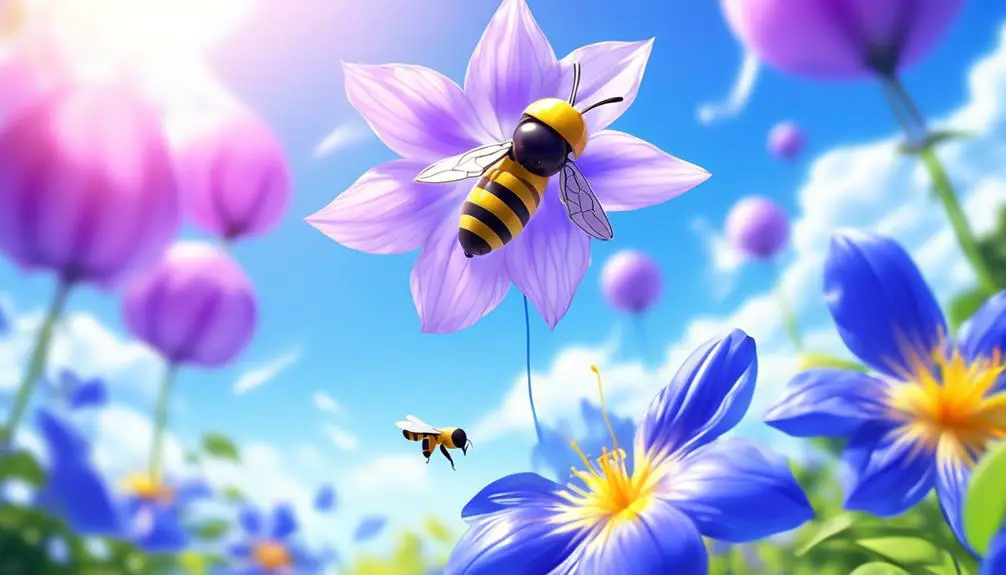
When considering the balloon flower, you'll find that these vibrant blue-violet blooms not only captivate the human eye, but they also offer enticing benefits to bees. Their deep color spectrum reflects ultraviolet light, a wavelength bees can see, unlike humans. This spectral reflection acts as a beacon, drawing bees towards the flower's nectar-rich center.
The balloon flower's structure also plays a significant role in its attractiveness. Its wide, bell-shaped corolla provides an easily accessible platform for bees. Unlike flowers with complex structures, the balloon flower doesn't require bees to navigate a maze of petals to reach its nectar.
Now, consider the nectar itself. Balloon flowers produce a generous amount of this sugary liquid, a critical energy source for bees. What's more, the nectar's high fructose content is particularly appealing. Bees prefer fructose over glucose due to its sweeter taste and the less energy it takes to metabolize.
Therefore, it's clear that balloon flowers aren't just aesthetically pleasing, but they're also a valuable food source for bees. Their vibrant color, simple structure, and fructose-rich nectar are a winning combination in attracting these vital pollinators.
The Science Behind Pollination
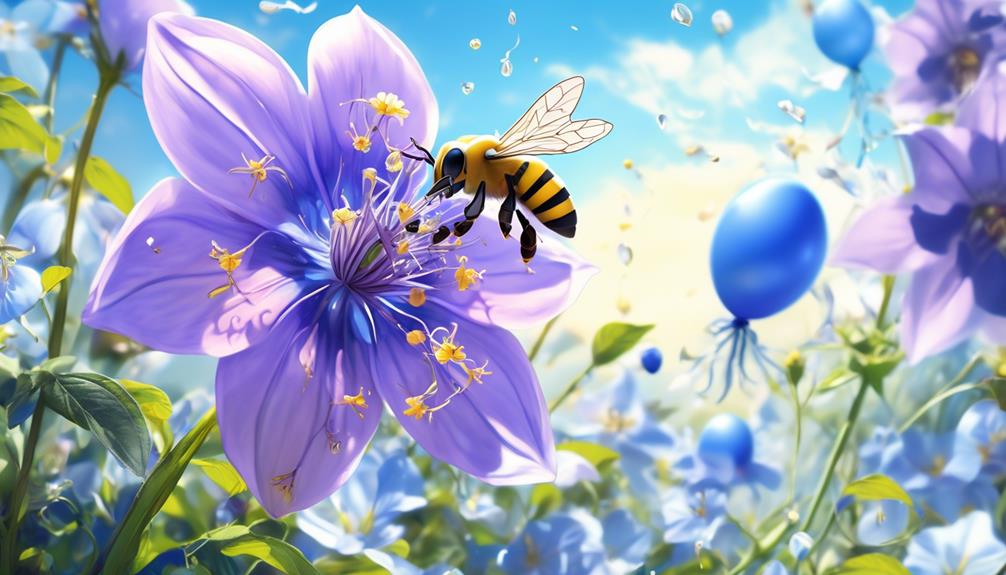
To fully grasp why bees are drawn to balloon flowers, it's essential to understand the science behind pollination, a fundamental process of the natural world. You see, pollination is a symbiotic relationship between bees and flowers. Flowers produce nectar, a sweet liquid that bees can't resist. When a bee lands on a flower to collect this nectar, pollen grains from the flower stick to the bee's body. As the bee moves from flower to flower, some of these pollen grains are transferred to other flowers, leading to fertilization.
Here's a simplified explanation of this process in a table:
Step | Process | Outcome |
|---|---|---|
1 | Bee lands on flower | Bee collects nectar, pollen sticks to bee |
2 | Bee moves to next flower | Transfers pollen to new flower |
3 | Pollen reaches flower's ovule | Fertilization occurs |
4 | Fertilized flower produces seeds | New plant generation |
This cycle continues, leading to plant reproduction and biodiversity. So, the attraction of bees to balloon flowers isn't just a fascination—it's a vital part of our ecosystem. Now, aren't you glad bees like balloon flowers?
Bees' Interaction With Balloon Flowers
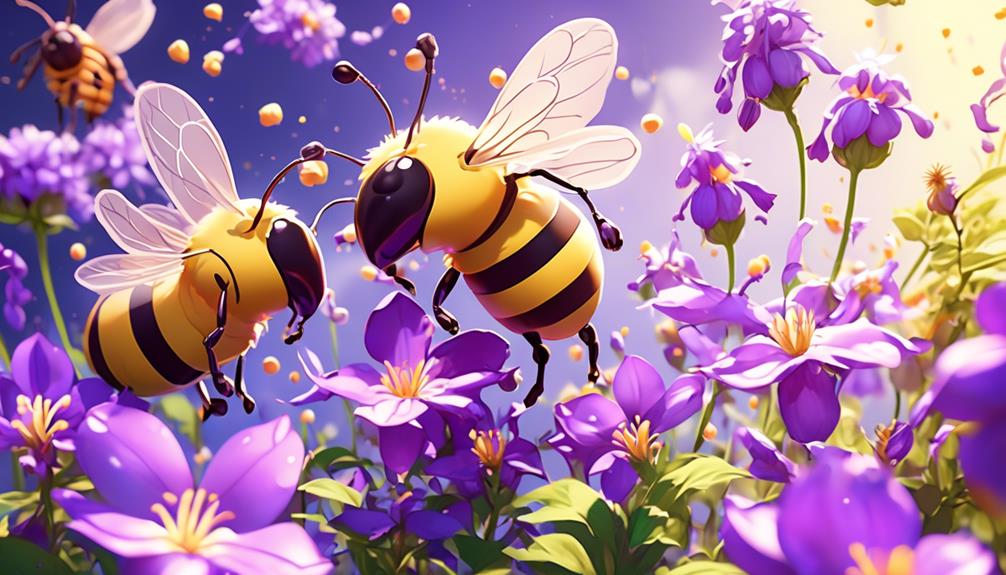
Diving into the heart of the matter, you'll find bees are particularly enamored with balloon flowers due to their unique characteristics that cater specifically to bees' needs and behaviors.
Balloon flowers, scientifically known as Platycodon grandiflorus, are rich in nectar, providing bees with the energy they need for their daily activities. They're also closely associated with the bees' color vision; blue and purple hues, typical of balloon flowers, are highly visible to bees.
Consider the flower's shape. It's tubular and deep, a perfect fit for bees' long tongues, allowing them to delve into the recesses for nectar extraction. Simultaneously, pollen adheres to their bodies, facilitating pollination as they move from flower to flower. This interaction results in a mutualistic relationship: bees get their food, and balloon flowers get pollinated.
Moreover, balloon flowers have a staggered blooming period, ensuring a steady food supply for bees throughout the season. As such, bees tend to return to these flowers, enhancing the chances of successful pollination.
Therefore, it's clear that the interaction between bees and balloon flowers is a beautiful example of nature's symbiosis, demonstrating how well-adapted these species are to each other's needs.
Enhancing Your Garden for Bees
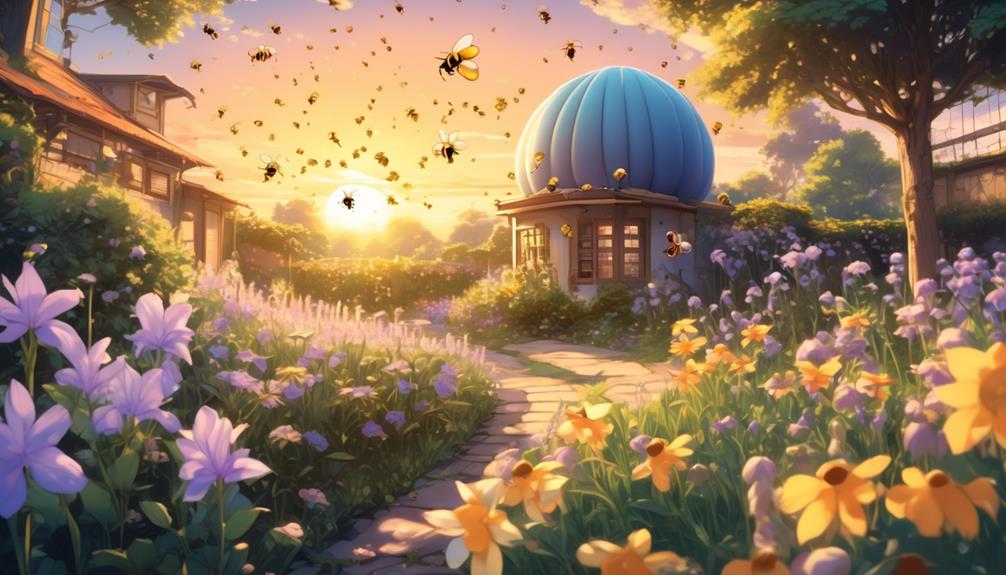
Understanding the fascination bees have for balloon flowers, you can strategically enhance your garden to become an attractive hub for these important pollinators. It's not as daunting as it sounds, and the rewards are immense for both your garden and the bees.
Firstly, consider the location of your garden. Bees prefer sunlit areas with wind protection. They're also attracted to clusters of similar flowers, as it allows them to forage efficiently. So, group your balloon flowers together for maximum appeal.
Secondly, timing is crucial. Bees need access to nectar and pollen throughout their active season. Balloon flowers bloom from summer to early fall, providing food when many other plants aren't blooming. However, it's essential to include early-spring and late-fall bloomers in your garden as well.
Water sources are also important. A shallow bird bath or a dish with pebbles can serve as an excellent bee watering spot.
Impact of Balloon Flowers on Bee Populations
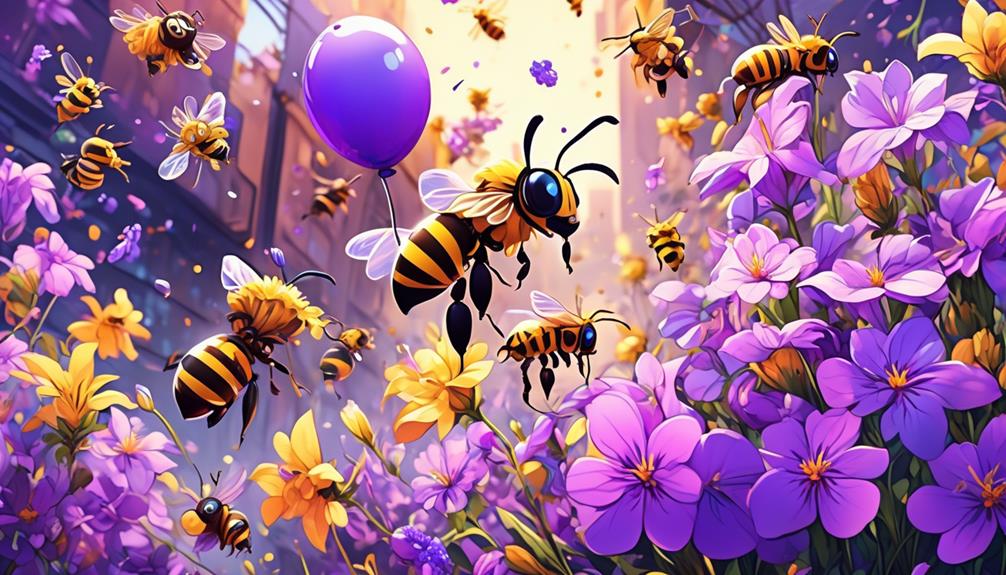
Having established how to make your garden a haven for bees with balloon flowers, let's now examine the significance of these plants on bee populations.
Balloon flowers, known scientifically as Platycodon grandiflorus, contribute significantly to the sustenance of various bee species. They serve as a rich source of both nectar and pollen, which are critical to bee nutrition. The nectar provides energy, while the pollen is a source of proteins and fats.
You'd be surprised to know that a single balloon flower can attract a multitude of bees, thus aiding in their proliferation. The vivid colors of these flowers, particularly the blue and purple varieties, are especially attractive to bees because these colors are more visible to them.
Furthermore, the unique shape of balloon flowers also plays a role. Their bell-shaped corolla helps protect bees from predators while feeding. This protection, in turn, increases the bees' foraging duration and efficiency, consequently boosting their population.
However, it's also crucial to note the potential risks. Overreliance on a single type of plant can make bees vulnerable to changes in its availability. So, remember to diversify your garden plantings to ensure a steady food supply for these essential pollinators.
Frequently Asked Questions
Do Different Species of Bees Have Different Preferences for Balloon Flowers?
Yes, different species of bees exhibit diverse preferences for balloon flowers. Some, like honeybees, are particularly drawn to their vibrant colors and sweet nectar.
Bumblebees, on the other hand, might show a lesser interest due to their preference for flowers with a landing platform.
Thus, it's crucial to observe and understand the behavior of various bee species to effectively attract them to your balloon flowers.
Can Balloon Flowers Be Harmful to Bees in Any Way?
No, balloon flowers aren't harmful to bees. In fact, they're beneficial! These flowers produce nectar and pollen that bees need for their survival. They're a food source that bees depend on.
Just ensure you're not using pesticides on your plants, as these can be toxic to bees. So, you're not only making your garden beautiful with balloon flowers, but you're also helping the bee population.
How Do Environmental Factors Like Weather and Season Affect Bees' Attraction to Balloon Flowers?
You're right to consider environmental factors. Weather and seasonality greatly affect a bee's attraction to flowers. For example, during colder seasons, bees mightn't be as active, thus reducing their interaction with balloon flowers. Similarly, rainy or windy weather can deter bees from venturing out.
It's also important to remember that the blooming period of balloon flowers, usually in summer, would also affect the bee's attraction to them.
Can Bees Help in the Propagation of Balloon Flowers?
Absolutely, bees can aid in propagating balloon flowers. When they land on a flower to collect nectar, they inadvertently pick up pollen on their bodies. As they move to the next flower, they deposit some of this pollen, facilitating cross-pollination.
This process is essential for the plant's reproduction and genetic diversity. So, while they're getting food, bees are also unknowingly playing a crucial role in the lifecycle of your balloon flowers.
Does the Presence of Balloon Flowers in a Garden Affect the Diversity of Bee Species Present?
Yes, the presence of balloon flowers can indeed affect the diversity of bee species in your garden. These flowers are known to attract a variety of bee species due to their vibrant colors and sweet nectar.
However, it's not just about bees loving them, it's also about the flowers needing bees for pollination. So, you're essentially creating a symbiotic relationship when you plant balloon flowers in your garden.
Conclusion
You've explored the fascinating world of bees and their fondness for balloon flowers. The delicate balance of pollination relies heavily on these tiny creatures' preferences.
By incorporating balloon flowers into your garden, you're not only creating a haven for bees but also contributing to their survival. Understanding this mutualistic relationship is key in supporting bee populations and subsequently, our ecosystem.
So next time you spot a bee buzzing around your balloon flowers, remember: you're part of a bigger picture.

